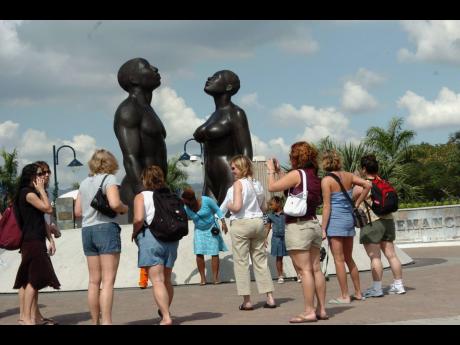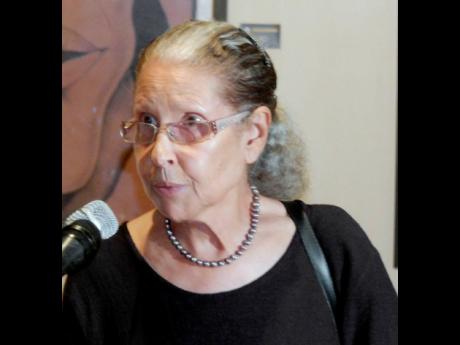Hope Brooks | Redemption Song is not a naked disgrace
Dr Carolyn Cooper does not like Laura Facey’s Emancipation Park monument titled Redemption Song. This is clear from her article that appeared in the Sunday Gleaner of August 4 “Emancipation Park monument a naked disgrace.” I have no problem with her not liking it. Everyone is entitled to their opinion.
In fact, she demonstrated this dislike in a discussion on radio – in which I participated – 21 years ago when the piece was first unveiled. However, I do think she should desist from writing these pejorative articles against the monument as many will believe her because of who she is. Carolyn Cooper, PhD, is a teacher of English language and literature and a specialist on culture and development.
According to Cooper, the monument is a “truly perverse representation of emancipation” and describes the monument thus “… two naked figures, male and female, standing apart, hands at their sides, heads uplifted, without eyes, thighs partially amputated, trapped in a pool of water! The overwhelming message is impotence.”
I wonder if Cooper has ever taken a look at Edna Manley’s internationally famous sculpture Negro Aroused. (I say internationally famous based on the number of requests received by the Edna Manley Foundation to use or exhibit the image of “Negro Aroused” in publications and exhibitions overseas.). David Boxer, in his book, Edna Manley Sculptor Pg. 24 has this to say about the piece: “This half figure of an unmistakably black man, his gaze turned skyward is a symbol of a search; a vision of a new social order, a New Day.” Negro Aroused exhibits many of the same sculptural conventions that the Emancipation Monument does. The same naked figure, the same upward- facing head, the same partially amputated thighs, the figure likewise motionless and the arms peacefully clasped. I wonder if Cooper also considers Negro Aroused a perverse representation or one of impotence!?
POOL OF WATER
Then there is the comment about the pool of water ipso that “only mad people bathe in public”. It is clear that water is used as a symbol of washing away or cleansing three hundred years of slavery – quite a different thing from taking a bath in public!
Cooper goes on to say: “There is none of the epic grandeur of Chief Takyi’s rebellion against enslavement …” And to underline her meaning, she quotes Claude McKay’s famous poem “If we must die, let it not be like hogs ...
“Like men we’ll face the murderous, cowardly pack
Pressed to the wall, dying, but fighting back!”
Broken chains would have been a far more effective representation of freedom than naked passivity, says Cooper .
I gather from this that Cooper thinks that what should have been portrayed is the brutal past, the violence, the war cry of enslaved Africans in the Morant Bay Rebellion or the Haitian Revolution.
In other words, the image should tell a story or portray the struggle for freedom. Something that does not require too much thought from the viewer.
But it is well known that storytelling is the lowest common denominator of image making. A work of art must do much more than that. First, it must require some input of thought and emotion form the viewer. There must be some exchange between artist and audience. And if this is successful, then the experience makes the creative journey worthwhile
Finally, I would mention Cooper’s comments about the artist Laura Facey Cooper ipso that “Laura Facey is white” and “out of touch with black culture”. This comment surprises me coming from someone who is academically trained. Perhaps it tells us more about Cooper’s prejudices than anything else. Where is the evidence for this statement? Laura Facey Cooper was born in Jamaica of a white mother and a coloured father. By all standards, therefore, she is not white, and certainly, by American or European standards she would be black.
Cooper’s view, therefore, is unsupported by fact. Besides, to suggest that skin colour or social class disqualifies a person from understanding black or any culture is ludicrous.
I am not here to say whether the emancipation monument is a great work of art or not, but it is interesting that it has generated so much discussion.
Cooper states that she cannot understand why the judges chose this piece to represent emancipation. There must be a judges’ report somewhere in the Heritage Trust archives if one takes the trouble to look.
FREEDOM FROM SLAVERY
The word emancipation means freedom from slavery, and I believe that this design may have been chosen precisely because of the one literary image that this design presents. The design with upward-looking heads is suggestive of a people looking forward and upward as they undertake their journey into the future as free people. To black people, that is what emancipation embodied. Emancipation meant freedom, and what image does that have? Is it the violent struggle undertaken by those in slavery if one looks back at the past, or should it be looking to the future? A future full of “promise” a much more difficult idea to embody into an image. There is no “image” of emancipation or freedom so we must engage our own imagination and our own understanding of what this could mean when viewing these two people who represent not only the past brutality, but mostly the future of promise.
This monument is cast in bronze, a material that will last for hundreds of years. This image of two people looking upward and forward is a timeless image that can speak to people who will be around certainly a long time after we are gone. The material itself will also change, and in time, will develop the blue-green patina, known as verdigris, that bronze develops with time. This notwithstanding the coat of black paint the misguided owners gave the monument in 2017 (see The Gleaner article published Friday, December 1, 2017). This is the true beauty of bronze and will make the monument more beautiful and will change the black patina it now has, a patina that, in my view, is too literal.
- Hope Brooks is the retired vice principal of Edna Manley College for the Visual and Performing Arts. Send feedback to columns@gleanerjm.com.


